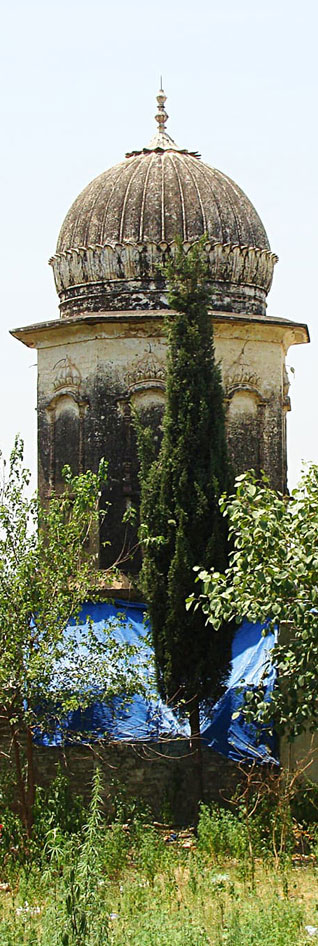Partition
The Lost Gurdwaras Of Potohar
ZULFIQAR ALI KALHORO
In the aftermath of war or exodus, when one community is forced to leave its religious or secular buildings behind, there is always another community which occupies these buildings.
The same occurred after the Partition of Punjab and the creation of India and Pakistan.
A majority of the buildings which once belonged to the Sikhs were given to refugees fleeing from the newly carved India. These families still live in these buildings, but I was surprised to discover that the structures and the artwork on the walls were still intact.
While traveling to the Kallar Syedan Tehsil, I came across several Sikh gurdwaras and monuments gracing the landscape of this region.
Three of the gurdwaras are located at Kanoha, Doberan Kalan and Mohara Bhatta, and are especially noted for their elegance and paintings. Of these, the gurdwara located 10 kilometres from Kallar Syedan at Kanoha is the most prominent.
I have been to Kanoha many times. The gurdwara here is conspicuous from a distance. Presently, it belongs to a Muslim family that has turned it into a living quarter. I greatly appreciated that the Potoharis occupying these buildings respect other religions, and have taken care not to deface any of the paintings inside or inscriptions on the buildings.
Historically, the gurdwara was used to meet the religious and social needs of the Sikh community here. Guru Hargobind, the Sixth Master (1606-1644), is believed to have first used the word 'gurdwara'.
Before that, the name used for such structures was 'dharamsala', which means a rest house for travellers in its normal Punjabi context, but was used in the early days of Sikhism to denote a room or building used for kirtan and prayers.
The gurdwara of Kanoha is a very large three-storied structure crowned with a dome – a distinctive feature of the Potohari style of gurdwara. Built on a square plain, it formerly housed Sikh families who would visit here to recite the Guru Granth Sahib and and meet as a sangat.
There are arches on all four sides of the structure, adding a symmetrical beauty to it. On the second and third storeys, and on all four sides of the building, there are false jharokas. Each of the four sides also has an entrance, so the gurdwara has four entrances in all, though the western one has been closed by the current occupants.
Right above each of the entrance, there is an inscription in Gurmukhi.
The main entrance of the gurdwara opens to the south. From this entrance, one enters the main hall, which has now been divided into small cells lying to the right and left, flanked by deep recessed arches.
The distinctive feature of the main hall is the foliated pillars and inscriptions fixed on the eastern wall. Formerly, it was adorned with paintings. Unfortunately, now, the plaster has peeled off.
The first and second floors have been turned into living quarters, where family members sleep at night. Several cots lie around in the rooms on the second floor.
One has to climb almost 40 flights of steps to reach the canopy that crowns the upper part of the gurdwara. It is octagonal from the inside and square from the outside. It is crowned with a ribbed-dome with a finial on top. One finds kiosks on the four corners of the canopy, which were apparently created to add beauty to the structure. Standing here under the canopy, one can enjoy a panoramic view of the Kanoha Village, as far as Chau Khalsa.
Apart from the Kanoha gurdwara, there is another gurdwara located in the Doberan Kallan town. This gurdwara is comparatively smaller in breadth, but it is very tall. The lower part or sanctum of the gurdwara is square, whereas the upper part is octagonal and crowned with a ribbed-dome. The octagonal portion of the gurdwara is decorated with false jharokas.
The Mohara Bhatta gurdwara is noted for its shikara. The sanctum of the so-called gurdwara is decorated with split arches which can be found on the eastern, western and northern walls. The entrance of the gurdwara opens to the south. The main hall of the gurdwara is located north of the sanctum. Its door also opens to the south. This hall is decorated with cusped arches. The shikara of the gurdwara is adorned with painting, traces of which can still be seen.
I have never seen a gurdwara of this style, with a towering shikara, in the entire Potohar region.
"This is a temple not a gurdwara," I said to an occupant, who disagreed and confidently said, “It was a gurdwara and it belonged to Sikhs.”
Needless to say, the Punjab tourism department, should chalk out a viable strategy to promote religious tourism in the Kallar Syedan Tehsil. These wondrous and historically rich gurdwaras can be a great tourist attraction; Sikhs who visit Gurdwara Panja Sahib at Hassan Abdal should also be able to come to here.
[The author is an anthropologist and teaches tourism, globalisation and development at the Pakistan Institute of Development Economics, Islamabad, Pakistan.]
[Courtesy: Dawn. Edited for sikhchic.com]
July 29, 2015



